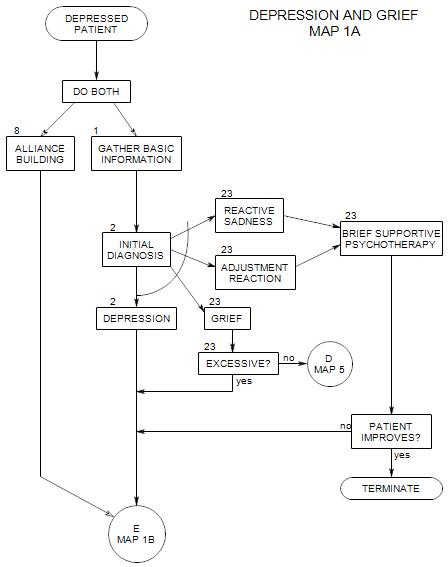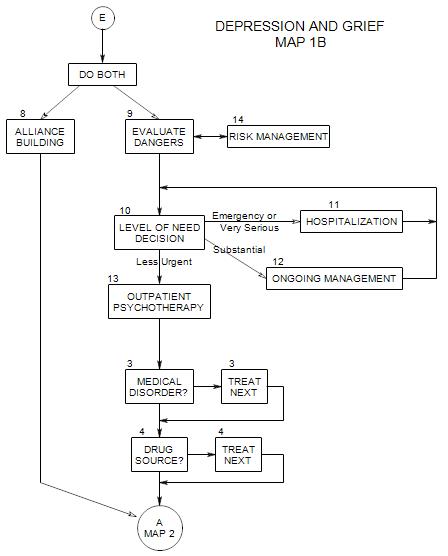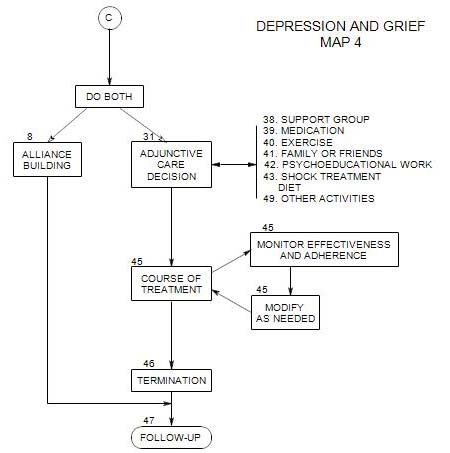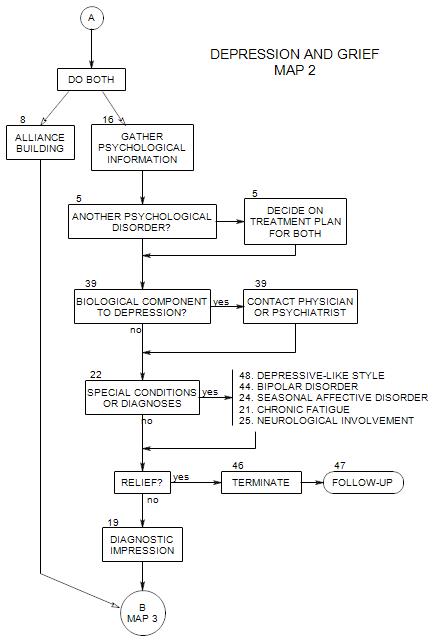
SECTIONS: 5 | 8 | 16 | 19 | 21 | 22 | 24 | 25 | 39 | 44 | 46 | 47 | 48
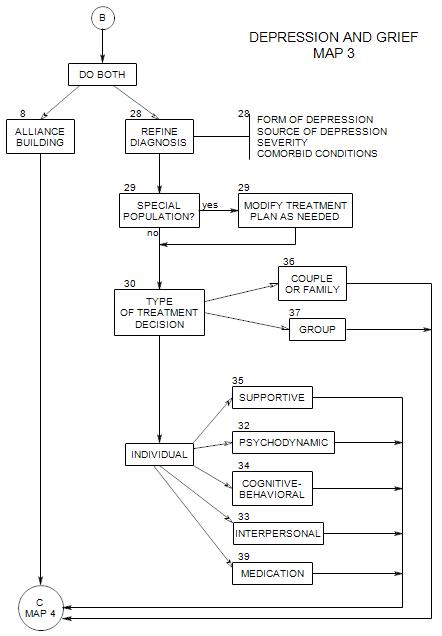
SECTIONS: 8 | 28 | 29 | 30 | 32 | 33 | 34 | 35 | 36 | 37 | 39
Follows Section 2 on Map 1A
23a. Identification of Grief
Grief is a normal, adaptive reaction to a major loss, including loss of a loved one, a relationship, a body part, one’s freedom, financial independence or security, etc. In this case, it is very likely that the person can point to a specific loss or set of losses as precipitating the feelings that brought him/her to you.
Intense grief may last for several months, and less intense grieving may continue for two or three years.
In many ways, grief leads to symptoms similar to those of depression. Some common symptoms of a grief reaction include…
- Feelings of sadness following an identifiable loss of someone or something valued highly by the person. A person can also grieve in anticipation of a major loss, as when a loved one is in the process of dying.
- The person may or may not be consciously aware of the loss that is leading him/her to grieve.
- Grief may include physical symptoms, such as loss of appetite, sleep disturbance, or neglect of his/her physical appearance.
- There is typically little or no loss of self esteem
- There is no implication of psychological disturbance.
Note that depression can also follow an identifiable loss, and that grief can lead to depression over time.
Expect greater reaction if a significant person has died, with substantial recovery within a year. When the loss is of a less central person or a significant possession, or through moving, expect less intense but possibly longer lasting depression.
Often there is a resurgence of grief on significant dates following the loss, for one to several years, especially around…
- anniversaries shared with the lost person.
- holidays in which the lost person participated, etc.
- visits to places associated with the person
- activities associated with the person.
Primary treatment of grief is discussed in Section 6 and adjunctive care in Section 7.
23b. Identification and Treatment of Reactive Sadness
Reactive sadness is a normal response to relatively minor setbacks in life. Although the person may experience feelings generally called grief or depression – sadness, despair – they are appropriate for the circumstances, they aren’t seriously debilitating, they don’t reflect pathology, and they don’t require treatment.
- the precipitating event will probably be within the range many people encounter
- information and reassurance can be helpful to him/her
- the patient may fully expect to return to a better emotional balance with the passage of time alone.
Typically the person only needs support or some brief cognitive treatment. The feeling may be so unpleasant that the person need reassurance that it is “normal”. He/she may need to talk about the loss and its implications for future life, and there may be some thoughts about the impermanence of life or its unpredictability.
The adjunctive care suggestions for grief may be helpful to a person with reactive sadness – especially, greater involvement with family, friends, or groups that the person already belongs to.
With time, the loss is usually assimilated and the person moves on.
23c. Identification of an Adjustment Reaction
An adjustment reaction is characterized by…
- a reaction to a clear change in the environment, in which
- the reaction seems excessive, relative to the amount or degree of stress, and
- there is a substantial negative impact on patient’s mood or functioning.
Adjustment reactions are commonly described as self-limiting; and insurance companies may not pay when a patient is given this diagnosis. However, an adjustment reaction should be taken very seriously, treated, and evaluated for risks.
An adjustment disorder may produce a variety of symptoms, including depression, anxiety and angry acting out. If anxiety is a major symptom, refer to the Anxiety Treatment Map for help. Depending on circumstances and the patient’s other issues, the disorder may become disabling, and the person may even become suicidal.
23d. Treatment of Adjustment Reactions
Psychotherapy commonly involves…
- thorough exploration of the stressor and its meaning to the patient.
- exploration of prior stressful experiences that may have affected the patient’s interpretation of this one.
- examination of the patient’s ability to tolerate stresses.
- evaluation of the patient’s support systems [family, friends, etc.]
- work on strengthening the patient’s defenses.
- some form of graded experiences in which the patient explores and extends his/her ability to deal with similar situations in the present and future.
Adjunctive care of adjustment disorders can include…
- family therapy, if the stresses are family-related
- job or career counseling
- training to help the person’s work performance
- additional education to put the person in a better competitive stance
